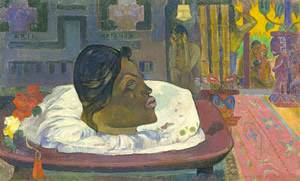
Paul Gauguin: “Arii Matamoe” (“The Royal End”), 1892

The Getty Center in Malibu
Getty Museum acquires an important Tahitian painting by Paul Gauguin
Source: The J. Paul Getty Museum
]]>
March 14th 2008 – The J. Paul Getty Museum announced yesterday the acquisition of an exceptional painting by Paul Gauguin (1848-1903) that dates to his first extended stay in Tahiti. Arii Matamoe (The Royal End) (1892) joins the Museum’s collection of impressionist and post-impressionist paintings, which includes works by van Gogh, Cezanne, Monet, Degas, and Renoir. This new painting also joins three important works by Gauguin already in the Museum’s collection, including his experimental transfer drawing from his later Tahitian period, Eve (The Nightmare) (c.1899-1900); a black-chalk drawing from his first trip to Tahiti, Portrait of a Tahitian Girl (c.1892); and his wood sculpture, Head with Horns (1895-97).
“The acquisition of this painting marks one of the key moments in the history of our collection,” explains Michael Brand, director of the J. Paul Getty Museum, in making the announcement. “For several years, we have sought to acquire a great painting by Gauguin to accompany our post-Impressionist masterpieces by van Gogh and Cezanne, so we are delighted to have this powerful composition, which exemplifies both the artist’s fascination with Polynesian culture and his ties to French Symbolism, join our permanent collection.”
French artist Paul Gauguin was born to a certain level of privilege, but in 1885 his passion for painting led him to abandon his successful banking job and dedicate himself to painting full-time. Thereafter, he eschewed the mundane existence of the “civilized” world and sought out adventures in more “primitive” environments that would feed his artistic spirit, and where he could escape the modern world and be close to nature in a tropical paradise. In 1891, he journeyed to Tahiti for the first time and took up residence in Mataiea Village. During this first stay in Tahiti, Gauguin became obsessed with the lush Tahitian landscape and featured it prominently in his genre scenes. Painted in 1892, Arii Matamoe (The Royal End) is a significant departure from the other works he painted at this time, first because it is an interior scene, but also because the painting is characterized by a certain morbidity that is quite different from the mood of sultry indolence that pervades most of his genre pieces.
In this composition, the severed head of a Polynesian male rests on a white cushion set upon a low table in a richly ornamented interior. The decapitated head dominates the foreground of the canvas and confronts the viewer with a disturbing vision-eyes rolling backward, jaw thrusting out, lips parted, and teeth bared. Behind this nature morte , a nude female figure crouches, cradling her head in her arms in a display of grief and mourning. She is framed by skull motifs in the geometric patterning on the wall and by a fierce, stylized mask near the floor by the table. Above the mask, a screen of three bamboo poles partially conceals a figure lurking in the shadows and separates the crouching figure from another woman rising up who appears to be shouting or wailing. In the background, just beyond a narrow porch, sit two glumly impassive figures, one bearing a tool, possibly an ax, the other cloaked in red. A carved, double- tiki figure marks the threshold of the scene, dividing the spaces of the dead and living.
From the title and the imagery, one can discern that the painting is a fanciful evocation of Polynesian death rites. “Arii” signified “noble” or “nobility,” and “Matamoe” roughly translates as “sleeping eyes,” a euphemism for Death, hence we are faced with some kind of noble or royal death. Gauguin confirmed this interpretation with his own translation for his 1893 exhibition at Durand-Ruel’s gallery, la fin royale or the “royal end.” The painting may have been loosely inspired by the death of King Pomare V, which happened just after Gauguin’s arrival in Tahiti in 1891. In his memoir, Noa Noa , Gauguin treated the king’s death nostalgically as a metaphor for the death of Tahitian culture as a whole at the hand of European civilization and colonization. The painting does not correspond to any particulars from Gauguin’s account of Pomare V’s funeral ceremonies, but rather it evokes a general sense of the royal lying-in-state and the collective mourning for the dead monarch.
Notably absent from the recorded histories of Pomare V’s passing, yet fundamental to Gauguin’s composition is the decapitation motif itself. However, Gauguin often took liberties in his depictions of exotic cultures and regularly transposed European imagery into a Tahitian context, and it is likely he may have done so here. The artist’s obsession with severed heads predates his Tahitian sojourn and is derived from the French Symbolist milieu of the 1870s-90s, in the imagery of John the Baptist, Orpheus, and other famously decapitated figures. On a more personal level, Gauguin’s obsession with severed heads was triggered when he witnessed a public execution by guillotine of a convicted murderer in December 1888.
Read more about Paul Gauguin in Tahiti
Follow us on:

